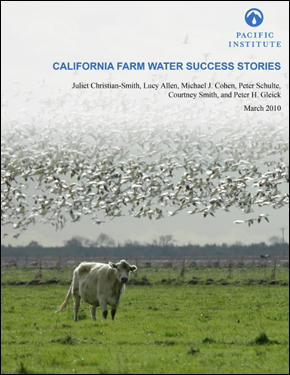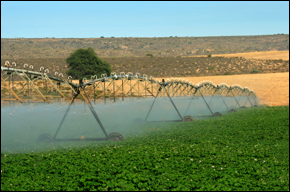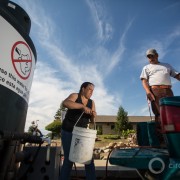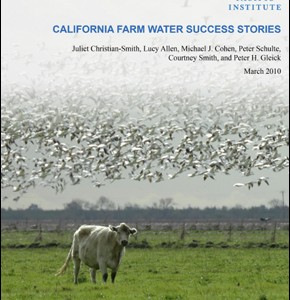California Farmers Can Save Water, Money, Says Pacific Institute Report
The water-scarce state can overhaul its agricultural water management by implementing clearer water targets, better economic incentives, and more direct communication systems, according to a Pacific Institute report.

By Brett Walton
Circle of Blue
California’s agricultural system, which already faces numerous obstacles because of the state’s limited water supply, can be improved if farmers are given better information, clearer water reduction targets and more funding for programs that implement water-efficient technology, according to a report released Wednesday by the Pacific Institute.
The report, California Farm Water Success Stories, analyzes seven case studies of innovative farm management techniques used in the state. These case studies provide context for a 2009 Pacific Institute report that found California’s agricultural water use could be overhauled using existing technologies.
Supplying the right amount of water for agriculture in the state is difficult. Farmers waste water if they do not know how much or when the crops need it, while lengthy lag times between water orders and deliveries from the canals compound the problem. It takes water six days to travel the 453 miles between the Hoover Dam and the Coachella Valley Water District in southern California.
A key component of any water management upgrade is increasing access to accurate data, said Dr. Juliet Christian-Smith, a senior researcher at the Pacific Institute and lead author for the report.
“Accurate measurement and monitoring is a core principle for any system,” Christian-Smith told Circle of Blue. “It’s not happening statewide due to the lack of regulation of groundwater. For things we don’t measure directly we use proxy measurements. To make matters worse, agriculture use surveys are outdated, some more than five years.”
Christian-Smith pointed to the state-wide irrigation survey, which was last completed in 2001. While the state has ordered that on-farm irrigation techniques be assessed every 10 years, Christian-Smith argues that it is financially possible to compile data annually or bi-monthly. Collecting the data only costs $10,000, she says.
Two case studies from the report highlight the gains from improving the flow of information.
One study involves Tom Rogers and his brother, who are almond growers in Madera County, located in the center of the state. They use smart irrigation scheduling–a combination of weather station data, soil probes and devices that measure a plant’s water uptake–to help decide when to irrigate and how much water to apply.
Rogers estimates that this scientific approach has reduced water use by 20 percent in some of his fields, according to the report. Tracking weather patterns has been a key component to the conservation success.
Some farmers, like Rogers, operate their own weather stations, while the state also provides data through the California Irrigation Management Information System (CIMIS). The system tracks precipitation, wind speed, air temperature, soil temperature and humidity from 130 stations around the state. These variables, combined with specific crop information make irrigation more precise.
Yet Christian-Smith acknowledges that use of CIMIS is limited, with mostly non-farmers signed up for the service.
“We need to get the word out. We need to expand the system so it’s more applicable to regional variations–to specific fields and elevations.”
Meanwhile improving the communications system in the Coachella Valley Water District (CVWD) is the focus of another case study.
The CVWD moved from a radio-based system to a wireless system in 2005. The upgrade allows the zanjeros, who manage the irrigation canals, to deliver water to users with less waste. Orders are now documented instantly, which has lead to more accurate billing and fewer spills from releasing more water than was requested. As a result, leaks and other maintenance problems are also identified and repaired faster.
“The improved communications system has had more benefits than I can list,” said Eric Urban, zanjero supervisor at CVWD, in the report. “It used to be that when you were in the field, you wished you were back at your desk where you could look up information. Now, we can be in the field and behind the computer at the same time.”
Implementing these changes statewide will be expensive, but the money is potentially available already, Christian-Smith said. California will be voting on an $11 billion water bond in November.
The transition to more water-efficient farming techniques will save money in the long term, but significant immediate costs are often an obstacle. Installing drip irrigation systems can cost $2,000 per acre, the report states.
Federal, state and district funding programs exist, but high demand for the low-interest loans means most applications are rejected, according to the report.
Meanwhile the California water bond doesn’t identify specific projects, just general spending goals, Christian-Smith said. This makes it difficult to know if more money will be available to finance on-farm efficiency improvements.
“[Water management] is not rocket science. People have known about these techniques for a while, but there’s been no political will. It’s time we get serious about large-scale transition for water use, farmers and the environment.”
Brett Walton is a reporter for Circle of Blue. Contact Brett Walton
Read more on water problems in California here. Watch video interviews with Californian farmers and water managers from the report at the Pacific Institute Web site.
Brett writes about agriculture, energy, infrastructure, and the politics and economics of water in the United States. He also writes the Federal Water Tap, Circle of Blue’s weekly digest of U.S. government water news. He is the winner of two Society of Environmental Journalists reporting awards, one of the top honors in American environmental journalism: first place for explanatory reporting for a series on septic system pollution in the United States(2016) and third place for beat reporting in a small market (2014). He received the Sierra Club’s Distinguished Service Award in 2018. Brett lives in Seattle, where he hikes the mountains and bakes pies. Contact Brett Walton










Trackbacks & Pingbacks
[…] to 70% of the freshwater in the world is used for agricultural purposes. By improving irrigation practices, it can help with supply and demand gaps. Technology is proving to be a valuable resource for more […]
Leave a Reply
Want to join the discussion?Feel free to contribute!